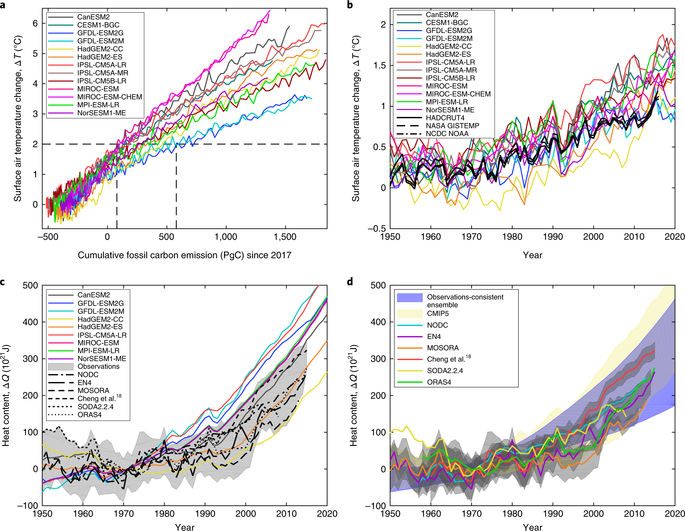Nature Geoscience ( IF 15.7 ) Pub Date : 2018-01-22 , DOI: 10.1038/s41561-017-0054-8 Philip Goodwin , Anna Katavouta , Vassil M. Roussenov , Gavin L. Foster , Eelco J. Rohling , Richard G. Williams

|
To restrict global warming to below the agreed targets requires limiting carbon emissions, the principal driver of anthropogenic warming. However, there is significant uncertainty in projecting the amount of carbon that can be emitted, in part due to the limited number of Earth system model simulations and their discrepancies with present-day observations. Here we demonstrate a novel approach to reduce the uncertainty of climate projections; using theory and geological evidence we generate a very large ensemble (3 × 104) of projections that closely match records for nine key climate metrics, which include warming and ocean heat content. Our analysis narrows the uncertainty in surface-warming projections and reduces the range in equilibrium climate sensitivity. We find that a warming target of 1.5 °C above the pre-industrial level requires the total emitted carbon from the start of year 2017 to be less than 195–205 PgC (in over 66% of the simulations), whereas a warming target of 2 °C is only likely if the emitted carbon remains less than 395–455 PgC. At the current emission rates, these warming targets are reached in 17–18 years and 35–41 years, respectively, so that there is a limited window to develop a more carbon-efficient future.
中文翻译:

根据观测和地质限制,升温至1.5°C和2°C的途径
为了将全球变暖限制在商定的目标以下,需要限制碳排放量,这是人为变暖的主要驱动力。但是,预计可排放的碳量存在很大的不确定性,部分原因是地球系统模型模拟的数量有限以及它们与当前观测值之间的差异。在这里,我们展示了一种减少气候预测不确定性的新颖方法。利用理论和地质证据,我们产生了一个非常大的集合(3×10 4)与九个关键气候指标(包括变暖和海洋热量含量)的记录非常匹配的预测。我们的分析缩小了变暖预测的不确定性,并减小了平衡气候敏感性的范围。我们发现,要实现比工业化前水平高1.5°C的升温目标,就要求从2017年初开始的总碳排放量低于195-205 PgC(在超过66%的模拟中),而要达到的升温目标为仅当排放的碳保持低于395–455 PgC时,才可能达到2°C。以当前的排放速率,这些变暖目标分别在17-18年和35-41年内得以实现,因此发展碳效率更高的未来的窗口有限。











































 京公网安备 11010802027423号
京公网安备 11010802027423号